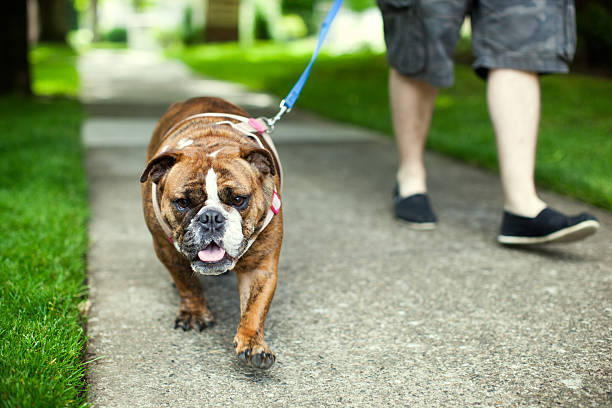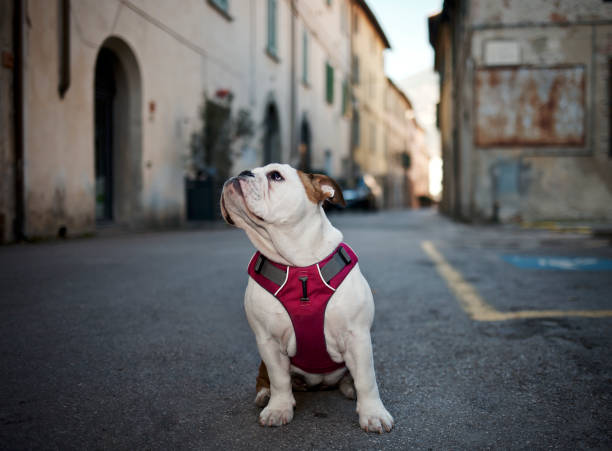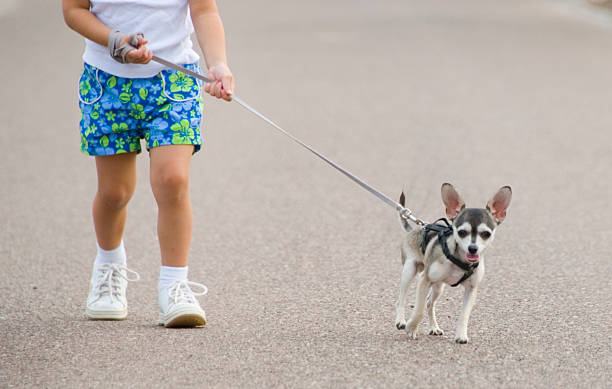Are you struggling to keep your dog’s collar from slipping or sliding? Learn how to tighten a dog collar properly to ensure a snug and comfortable fit for your furry friend. Our step-by-step guide will show you the best way to adjust different types of collars, from flat collars to martingale collars. Avoid choking or injury caused by an ill-fitting collar and keep your dog safe and happy.
If your dog’s health and well-being are important, you should pay close attention to how the collar is adjusted. The way the dog collar fits affects how your dog behaves and breathes. If the collar is overly tight, it may itch the skin, put too much pressure on the veins, shorten the dog’s breath, and cause the fur to fall out.

In contrast, a loose dog collar increases the likelihood of an accident because your dog can get out of it and cross the street. Additionally, while the dog is playing, it may stick its legs or paws in the gap, getting stuck. Therefore, you must modify the dog collar size following the dog’s lower neck to prevent these situations.
What Makes a Dog Need a Collar?
You have come to the right place if you’re looking for an explanation of why a dog requires a collar. We’ll outline the key justifications for why your dog must wear a collar. The typical collar comprises leather or cotton with a metal buckle or plastic snap. It serves as official identification for your dog rather than just an adornment.
The main distinction between stray dogs and pet dogs is their collars. A collar will therefore protect your pet from the municipal cooperation personnel while they are out looking for wild animals to trap. A smart dog collar is also required to restrict your dog’s movement, whether inside or outside the house, for its protection.
This chore is made easier for you and gets your dog ready for a picnic with the help of the long leash, harness, or strap with the collar. You may take them along on outings and picnics without worrying about losing them if you have a dog collar and leash. The ID tag is still another crucial factor. Whether you’re going out or not, it’s always a good idea to tack identification tags onto the dog collars.
Your dog might try to flee the area or wander erratically outside the confines of the house, so you can only partially rely on them. The identifying tag will assist you in getting your dog back in such circumstances. You can include your phone number, address, or other contact information if your dog has any urgent medical concerns. Therefore, a collar is required to connect the identity tag, making this one of the main reasons your dog needs a collar.
How to Change the Collar on Your Dog
Dog owners typically purchase dog accessories online, making it difficult to gauge the size and fit accurately. As a result, the new collar size always differs by a few inches. You may alter the product to fit the size of the dog’s neck rather than having to replace it regularly. You might use a measuring tape for this purpose, after which you can examine the collar’s modules.
In developing dogs, checking the collar frequently is the ideal strategy to maintain fit. As your puppy gets bigger, the mass rises, allowing the collars to fit snugly. You can follow the steps below if you do not know how to adjust your dog’s collar.
Measure the Neck of Your Dog
You must measure your dog’s neck to acquire the ideal fit for the new collar. During this process, the measuring tape will be your best friend; wrap it around your dog’s lower neck and record the resultant measurement. To prevent cutting or to scratch the dog’s neck, use a plastic measuring tape instead of a metal one. Once you have the measurement, you can compare it to online websites’ reference sizing charts.
The collar should be moved to the proper module.
The collar must then be slid into the appropriate module. You must remove the collar to measure it for the dog’s neck size. The buckles on dog collars are typically adjustable, and the straps feature a variety of size-changing modules or holes.
You can use a marker or your finger to mark the position or the module as you measure the dog’s lower neck. Re-wrap it around the dog’s neck and securely fasten it. Doing this can modify an old dog collar to fit better as the dog’s lower neck grows and changes in size.
Examine It Frequently.
You must regularly check the collar on your dog. Once the dog collar has been adjusted, you cannot leave it that way indefinitely; you must monitor how well it fits. Over time, your dog will continue to grow and gain weight. So, the dog collar may become increasingly restrictive with time. Therefore, you will need to inspect it frequently for any changes in the fitting and re-adjust it as necessary.
By watching your dog, you can ensure it’s not too tight or loose. This proactive step will assist you in acting quickly to prevent harm to your dogs. So if you want your dog’s company for a longer period, there is no harm in keeping an eye on its collar.
How to Determine If Your Dog's Collar Fits Correctly

The animal itself is unable to verbalize its displeasure or agony. Instead, you will need to watch your dog spot any signs of discomfort from the collar. There are many indicators that the collar on your dog is not fitting properly. Therefore, if you are unsure of how to determine whether your dog’s collar is malfunctioning, you shouldn’t be concerned.
Shortness of breath, tiredness, irritability, chafing, loss of fur and changes in food habits are a few symptoms to watch out for. On the other hand, when performing a physical examination, you can evaluate the fit of the dog collar using the two-finger rule.
Rule of Two Fingers
The ideal technique to check whether the dog collar is properly fitted is to use the two-fingers rule. No special tools or apparatus are required. Your middle and index fingers will be used in their place. You place your middle and index fingers between the dog’s collar and neck to complete the process. Your dog collar fits perfectly if your two fingers move around without resistance.
It is too tight, though, if you have to exert too much power to enter the collar, and there is almost no room for movement between the collar and the dog’s neck. As the dog’s breathing may be hampered, you must immediately relax or reposition the collar.
Itchy, red skin
In addition to the two-finger rule, there are other outward indications that the collar on your dog needs to be adjusted. It is a clear sign that a dog collar is not fitting properly if you notice your dog continuously rubbing and scratching the area around its collar. The dog collar’s firm grasp may make the region itchy. Additionally, the area may get red due to frequent rubbing and friction between the collar and neck.
Additionally, breathing difficulty may be a warning sign that your dog’s collar is too tight. A dog collar that is too tight can also cause excessive pressure to build up around the neck, as evidenced by hair loss and chafing. Due to a strong grasp and considerable friction, bald patches may be around the lower neck region and where the dog collar is attached. So, if you wish to protect your dog from such suffering, you must be a diligent observer.
I always prefer collars
When walking dogs, collars should almost always be your first option. They offer a secure connection that has been utilized worldwide for a very long time. They range from straightforward slip-leads to a little more complicated.
Slip Lead (also known as a British Slip Lead occasionally)
This straightforward, one-piece collar and leash feature a loop for your hand on one end and a ring with the rope looped through to provide a loop for you to place over the dog’s head on the other end. A leather stopper on the dog’s end prevents the collar from slipping off, which might allow the dog to escape the lead. The slip lead is a quick and efficient method for swiftly leashing your dog and leaving the house.
Flat Collar
Flat collars are popular because they can be simple or stylish, depending on the pet parent’s preference. Usually fashioned of leather or fabric and fastened around the dog’s neck with a metal buckle or plastic snap. They resemble tiny belts in appearance.
The flat collar’s most crucial consideration is that it shouldn’t be overly tight or loose. If it’s too tight, the dog will feel uncomfortable, and if it’s too loose, the dog might be able to escape. The standard rule for flat collar sizing is that two fingers should fit between the collar and the dog’s neck.
However, even tight collars can ride over a dog’s head if the size of its head and neck are comparable. You can test this in your dog by placing a flat collar on your dog’s neck and attempting to pull it over its head. Your dog may simply back out of the collar if it goes over well. In these circumstances, I do not advise flat collars but rather a “cinching” collar, like a martingale, choke chain or harness.
Martingale Collars
I like Martingale collars for a variety of canines. They nevertheless prevent the dog from escaping while permitting a loose but comfortable fit. And when necessary, they enable the dog’s safe management by the walker. There are numerous martingale collars available with various adjustment options.
Martingales are either worn over the dog’s head and fastened with an adjustable buckle, or the ends are fastened together after worn around the neck like a flat collar. I like the snap buckle better since it makes it easier and faster to put the collar on the dog.
Pinch Collars
Pinch collars, also known as prong collars, can be helpful for some dogs, but they shouldn’t be used on dogs who haven’t been trained to utilize them. A pinch collar can help a dog fairly understand what the walker is communicating if it has been trained and is used to wearing one.
The most common error with pinch collars is that they are worn too loosely. When the collar spins around the dog’s neck, this may irritate the skin. It frequently fits loosely when you drape a closed pinch collar over the dog’s head.
Starting with one end in each hand, pinch a link to join the two ends over the dog’s neck, securing it behind the dog’s ears. This will ensure that the collar fits the dog properly. A small tug should be sufficient when utilizing a pinch collar to communicate with the dog.
Choke chains and collars Although the moniker might turn you off, properly used, these collars guarantee a dog’s safety if he tries to escape from the collar. But keep in mind that a choke collar shouldn’t apply pressure to the dog’s throat continuously. If the dog tries to escape or attack another dog, the collar will keep them both safe. If not, you should take the dog on a walk while wearing a loose leash to prevent the collar from pressing against the dog’s throat.
Choke collars, unlike other collars, should be put over the dog’s head and can be made of chains, fabric, or rope. When facing the dog and putting the collar over his head, the collar loop should form a “P.” The collars should be snug enough to fit two to three fingers beneath them. As a result, the pressure in the collar can be relieved when the leash is slack.
Conclusion

In other words, altering the dog collar is relatively easy to perform. You must be a keen and alert observer to prevent your dog from suffering. Adjusting a dog collar is easy, but you must pay close attention to sizes and specifications. Instead of using a metal measuring tape, measure your dog’s lower neck with a plastic one. Then, adjust the dog collar modules accordingly, re-wrap the collar around the dog’s neck, and remember to check it frequently as your friend develops over time.
Additionally, the two-finger rule, which is simple to use and provides the most accurate results, can be used to check how well your dog’s collar fits. You can also check for indications that the dog collar isn’t fitting properly. For instance, if your dog experiences shortness of breath or develops red, itchy skin around the collar, you must take immediate action. Most crucial, remember to include tags with important information on dog collars. We wish you and your dog a happy and healthy life together.
